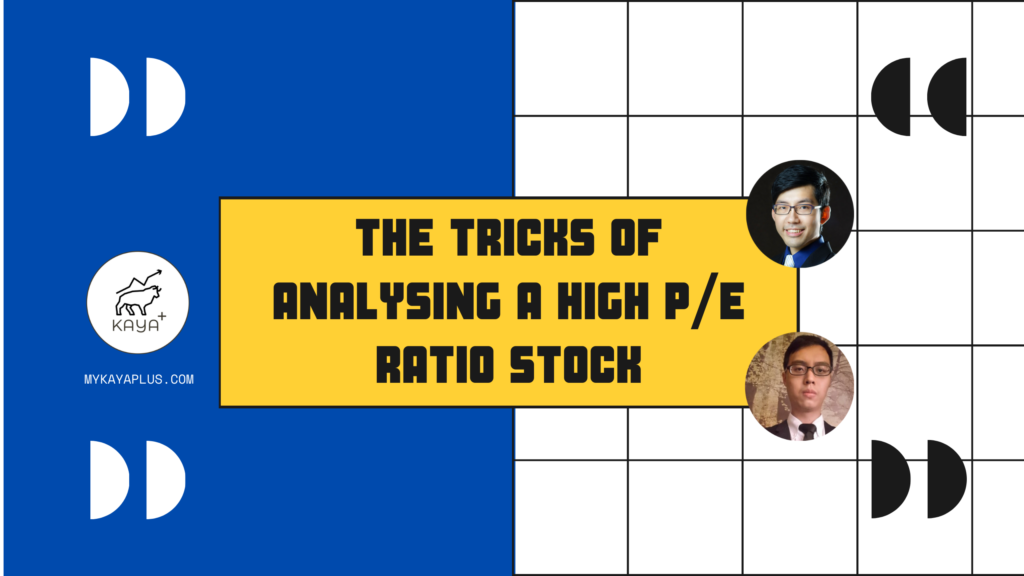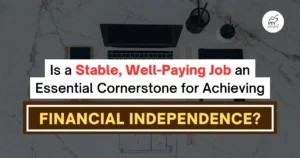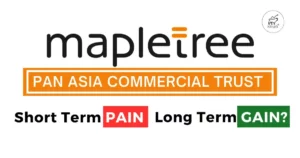The Tricks of Analysing A High P/E Ratio Stock

A high P/E ratio is LOGICAL if the company is growing rapidly or has a high profit margin💡. Want to know why? Check out the video! 😉😉
Transcript:
Choon Beng: Hi I’m Choon Beng, together with me is Joo Parn. We are from mykayaplus. So we decided to work out a series of videos during this lock down period, and the first topic that we want to share about is (the) P/E ratio. Joo Parn do you want start off with the defination of it?
Joo Parn: Sure, so P/E ratio is the most common term we come across in our investing journey. So in very very layman terms, if you buy a stock at RM10, while the company is just earning RM1, the P/E ratio is 10, simply by using the stock price which is RM10 divided by the earnings which is RM1.
Choon Beng: Yes, in other words, if the company continues to make RM1 every following year, we’re going to get back our investments in 10 year. Probably a lot of people who are new to investing will ask, how about those stock that are trading at P/E ratio of 50x or 100x, does that mean we need to wait for 100 years to get back our investment?
Joo Parn: Yeah, so there’s a reason why sometimes people are willing to pay a high price for a stock. So yeah, you’re right, if a company continues to earn RM1 every year, definitely you’ll need 50 years to get back your investment returns. But, if a company can earn more than RM1 the following year, then the P/E will normalize and becomes reasonable.
Choon Beng: Yes, as a layman, then probably the next question you’ll ask, like as the slides, how do you know a high P/E ratio is justifiable and logical? On this, our interpretation always come from the denimoniator of the formula, which is earnings per share, as the price is something we can’t tell, and it’s always driven by the market. So, we’ll suggest when you’re doing stock analysis, you should always ask yourself two questions. Joo Parn maybe you wanna start off with the first one?
Joo Parn: Yeah absolutely! So, the first question you want to ask whenever you come across a high P/E ratio stock is, whether the growth is rapid yet sustainable? So in very simple terms, if a stock is going to achieve higher and higher revenues in the following years, so yes the profit will also follow suit. Because revenue is directly proportionate to the earnings. When the revenue is high the earnings will also tag along. So, one good example of a company that actually exhibits this GoPro, Inc. Are you familiar with this company?
Choon Beng: Yeah yeah! I think a lot of you would also be familiar with this company. It’s a company that manufactures a lot of good wide lens adventure cameras. I would say when they first launch, based on the graph, sales was quite good. At the first phase, people were fighting to buy the stocks.
Joo Parn: Yeah, but what happened after that? Sales eventually hit a threshold and even though they really really made good cameras, the upcoming and future models just did not have any much addtional specifications. So from the graph you can see that once the sales actually hit a ceiling, then it started to drop down and normalize. And the share price also was affected.
Choon Beng: Yes, so probably the next slide you see how all this are related to each other. It’s quite clear that it’s a company purely riding on potential high revenue growth in the coming years, the high P/E ratio cannot sustain and eventually it will collapse when the revenue hit the ceiling. So, as a smart investor, of course, it is still a good investment if we are able realize the profit before it reaches the ceiling. We wanted to share another good example, besides GoPro, one of the popular stock at the moment which is Revenue Bhd, which you can relate back to the GoPro case. Because right now they are in an early stage, and they became popular as people start to chase after the stock, causing it to have a very high P/E. And, if you’re not familiar with Revenue Bhd, basically they are selling payment gateway machines, and they are pretty new to the market. And I believe they are maybe covering a very small part of the SME. So, it seems to be a very good stock to invest in right now. But when we want to analyse stock like this, at early stage with high P/E and high potential, how should we analyze?
Joo Parn: Ok, you’re right. Revenue Bhd is involved in selling payment gateway hardware solutions. But they are just very, very focused in Malaysia, and one day it will hit the threshold when the market becomes saturated. At that time, if the P/E is still very high, as investors we should take note whether it is a good time to realize any investment gains.
Choon Beng: Correct, correct. Take Revenue Bhd as an example, if you just relate their growth, it’s directly related to the numbers of SMEs in the market. Let’s say now they are capturing 10% of it, so probably when they hit about 80%, you should basically realised the profit before it hits the ceiling. Maybe we can summarise, in this way, if you’re going to buy a high P/E stock, just based on revenue growth, like GoPro, you need to have an exit strategy. You need to know that this stock will definitely have a threshold, and you should basically realized before it hits the ceiling. But coming back to Revenue Bhd, it’s quite different from GoPro, as they are not only basing off the payment gateway machine. They also have some recurring income.
Joo Parn: Yeah, so as you mention beside having high revenue growth by gradually slowly selling their payment gateway machines into the Malaysia SME market, of course their recurring revenue that they earned from credit card swips would also complement their future revenue portfolio well. But moving onwards, apart from looking at the rapid revenue growth, there’s another question you should ask when you look at a high P/E company that you are considering to invest into it. The next question is, “Is the company a monopoly that is having huge profit margins a potential valid reason to buy a company at a relatively higher P/E?”
Choon Beng: Any good example of this kind of stock?
Joo Parn: Yes, Of course! I guess everyone should also know about this company. This company is called Facebook Inc.! Do you think Facebook is a monopoly?
Choon Beng: Yes, yes. I believe everyone have this app on our mobile phone. We will open the app at least few times a day. We can say that it is the king of social media.
Joo Parn: Yeah exactly! But the Facebook we are using now is very different from the Facebook we started using 10 years ago. At that time it was a pure social media app where we use to keep in touch with out friends, view photos and also watch a bit of videos. But as of now, since their user base has grown so much, they have turned into a very lucrative advertisement space. With more and more ads popping up also! Even though you’re scrolling through your Facebook wall, even watching videos. We can see that their business is very lucrative, because they’re earning 30-40% of net profit margin on their advertisement business!
Choon Beng: Yes, so you can see that Facebook a very good example that it’s a company with very good business model, and this will actually help them to sustain a higher profit margin that can actually justify their very high P/E during their IPO time.
Joo Parn: Yeah exactly. When you look at Facebook stock price & P/E ratio movement historically, it is very different from GoPro. Imagine if you are smart enough back then, and you did your research and decided to buy Facebook due to huge room of profit margin potential and the right moment is eventually that once the earnings from the advertisement business kicks in, the P/E actually normalized down from 100 during IPO to a region of 20 as of currently.
Choon Beng: Yes. In short, what we are trying to say here is, when we look at high P/E ratio stock, we should definitely study their business model and try to understand whether they have a chance to monopolize or at least has some sort of unfair advantages to allow them to boost their margins over the years. This would give a good indication whether the high P/E is reasonable or not.
Joo Parn: Yeah, so before we end our sharing today, remember to always ask yourself, when you want to look to into investing companies with relatively high P/E. First – Is the company going to have higher growth in terms of revenue and is it going to be sustainable? Or – is the company having such a special economic moat or advantage that allows them to call the shots in terms of pricing and hence having very very high profitability. Only if one of this criteria or both of them are available, only then you should put this company in your watchlist and buy them at the right time.
Choon Beng: Yes, I think this conclude what we wanted to share today. Hopefully we shared something useful to you. Please leave your feedback or question at the comment section. If you have a specific topics that you want us to cover, just shoot us the request. dont be shy!
Joo Parn: Yeah, and don’t forget to like and subscribe yea!
Choon Beng: Yeah, see you next time!
P.S.: Think you have mastered the valuation of the P/E ratio? Check out our magic 4M analysis to screen out good companies from bad companies in less than 5 minutes!
DISCLAIMER
The information available in this article/report/analysis is for sharing and education purposes only. This is neither a recommendation to purchase or sell any of the shares, securities or other instruments mentioned; nor can it be treated as professional advice to buy, sell or take a position in any shares, securities or other instruments. If you need specific investment advice, please consult the relevant professional investment advice and/or for study or research only.
No warranty is made with respect to the accuracy, adequacy, reliability, suitability, applicability, or completeness of the information contained. The author disclaims any reward or responsibility for any gains or losses arising from direct and indirect use & application of any contents of the article/report/written material






